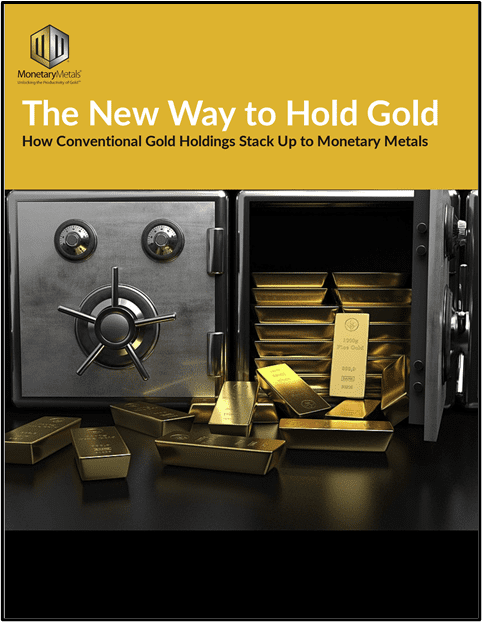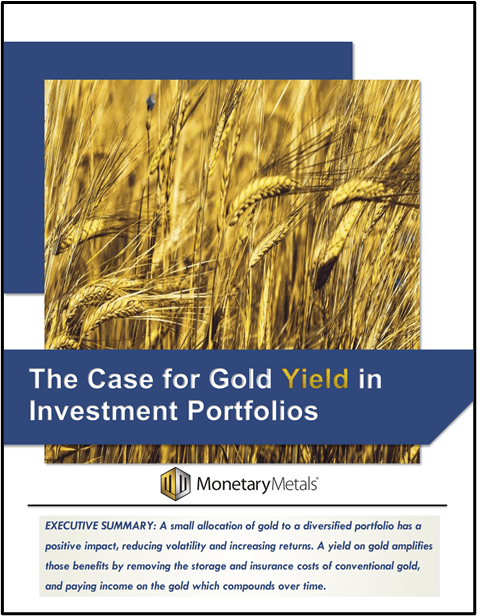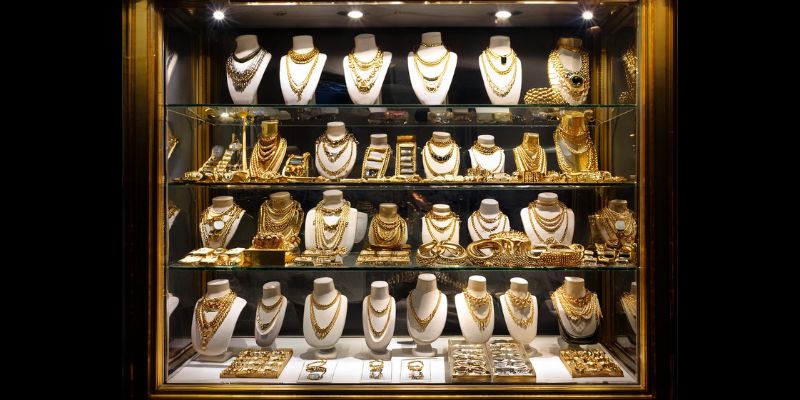The Monetary Metals Supply and Demand Report is the only accurate picture of the fundamentals of the gold and silver markets. We released a video that presents some of these ideas in an engaging format.
We provide a weekly letter based on data and analysis of the monetary metals: gold and silver. This article is an introduction to our approach and is a guide to understanding the terminology and graphs.
Stocks to Flows
Gold and silver are money because, unlike all other commodities, people accumulate them without limit. Virtually all of the gold ever mined in human history is still in human hands. The “stocks to flows” ratio (inventories divided by annual production) for gold is 80 years. For silver it is also measured in decades.
For other commodities, it is measured in months.
Think about this. It means that there is no such thing as a “glut” in gold or silver. If the wheat harvest comes in a few percent higher than expected, the price can crash. If oil consumption rises a little, the price can spike. But in the case of gold and silver, the value has nothing to do with either mine production or jewelry or electronics consumption.
Stability is exactly what we want and expect from money. The prices of gold and silver, as expressed in dollars, are unstable, not because of gold and silver, but because of the dollar itself.
This means that you cannot analyze the fundamentals of gold and silver with conventional techniques. It is not possible to predict changes in the prices by looking at “supply” (i.e. mining and recycling) and “demand” (i.e. jewelry and electronics). All of those huge inventories are potential “supply”, at the right price. Everyone on the planet is potential “demand”, at the right price.
Central Bankers and Smart Money
Some analysts point to the same fundamental story in every article. Central banks are issuing money and other big problems are occurring in the world’s financial system. It’s true. But it was true before the big price crash on April 15, 2013 and it is true today. While this is a good reason to own gold, this isn’t good information to trade gold.
Another approach is to try to assess whether gold is being bought or sold by central banks, sovereign wealth funds, or other high profile market participants. This is often based on the assumption that the buyer represents the “smart money” and the seller is “dumb money”. People often study the open interest in the futures market, ETF inventories, COMEX inventories, etc.
Technical Analysis
Other analysts prefer to look at price charts and perform technical analysis. This is based on using past price movements to predict future price moves. It works sometimes, though it gives a limited picture. The price of something can also move for other reasons. These reasons are sometimes obvious at the time, though it is often not clear until afterwards, if ever.
The Fundamental Approach
Monetary Metals was founded on a different approach. We do not look at the price per se. We look at the fundamentals of supply and demand. We do this by studying the spread between two prices: the spot market and the futures market, called the basis.
It is helpful to use the example of a non-monetary commodity to understand how the basis shows the fundamentals of supply and demand. Imagine driving a grain truck to a town with grain silos right before the harvest. Workers are cleaning off the equipment and washing the interiors of the empty storage bins. You ask how much money to fill up your truck. They will laugh until you take out a stack of money. Someone may quote you a price: $25 per bushel is the price to get wheat today. If you take it, they will have to pay a bakery to sit idle for a week until the harvest, and pull wheat out of the supply chain.
But if you can sign a contract for delivery next month, the price is $7. This case, where the price in the spot market is greater than the price in the futures market, indicates scarcity. Of course, this makes sense that wheat would be scarce a few days prior to the harvest. It is perishable, which means every bushel produced is consumed. There are no permanent hoards.
This case has a technical term, which is backwardation.
Backwardation and Scarcity
Here is the proof that backwardation means scarcity. Suppose someone had wheat in a warehouse. How could he profit from the situation? He could sell you the wheat at $25 and immediately buy a contract to get the same amount of wheat delivered in one month. This is an arbitrage called decarrying the wheat. Decarrying is pulling the commodity out of the warehouse, buying an equivalent amount in the futures market, and keeping the profit (in this case 25 – 7 = $18). Obviously, if anyone had wheat, he would take the free $18 offered by the market. In doing this, he would reduce the backwardation. If others had wheat, they would do it and reduce the backwardation further, and so on.
The opposite example occurs a month later. When the harvest comes in, the market is overflowing in wheat. But if a bakery wants to contract to guarantee its wheat supply for delivery in 8 months, the price is higher on the 8-month future than in the spot market. The technical name for this condition is called contango. Contango implies that there is plenty of the good, or at least that there is no scarcity.
In contango, one can make a profit by buying the commodity and selling a futures contract against it. This is called carrying it. In the meantime, one pays interest on the money one borrowed to buy the wheat and one has costs to store and insure it in the meantime.
In brief, the basis is a measure of availability of a commodity to the market. When the basis is well above zero (i.e. well into contango territory) and rising, then the good is abundant. When the basis falls below zero, then the commodity may be in backwardation. Just as backwardation is the opposite of contango, there is a spread which is opposite of the basis. It is called the cobasis. When the cobasis is above zero, that is the precise definition of backwardation. When you hear backwardation, you should think scarcity or shortage.
Gold and silver are different than wheat. As we said earlier, there is no such thing as a “glut” and for the same reason there is never a shortage either. Backwardation in gold means there is a shortage of gold to the market. There is no lack of gold available to decarry, unlike the case of wheat. But for whatever reason, owners of gold are reluctant to entrust it to the market, even to make a profit. Gold backwardation should never happen. It did not happen until December 2008. Since then, it has been occurring intermittently.
Backwardation in gold is a sign that the regime of irredeemable paper money based on the dollar is coming to an end. When it becomes permanent, then gold will no longer be offered in exchange for dollars (or yuan, pounds, euro, etc.) There will be no gold “price”. In other words, paper money will be worthless.
Temporary Backwardation
This is not merely academic. In general, the positive basis (i.e. contango) is disappearing. This is a process of gold withdrawing its bid on the dollar. One cannot understand this if one lives in the dollar bubble, looking at the gold “price” as if it were comparable to the price of Apple shares or crude oil. It would be better and more accurate to think of the dollar price, measured in milligrams of gold or grams of silver.
In the meantime, we have temporary backwardation. Each futures contract drops into backwardation as it approaches expiration.
In temporary backwardation, when each futures contract approaches expiration, it is pulled into backwardation. The bid drops, which causes the basis to drop significantly.
One explanation is that this could be due to the contract roll. Most traders who buy futures use leverage. They do not wish to take delivery of the gold, and cannot take delivery because they don’t have the cash in their account. So they must sell before First Notice Day. This selling presses down the bid on the future. The basis, therefore, drops.
But the mechanics of the contract roll does not fully explain the phenomenon of temporary backwardation. While it may not herald the end of the dollar just yet, it is a sign of cancer in the brain of the system. The reason is simple. Increasingly post-2008, when people buy gold they prefer metal that they can hold in their hand to a futures contract. The consequence is that the price on the futures contract has a tendency to sag below the price of the metal itself. Buying of futures has become relatively soft relative to buying of gold metal.
This does not mean that the price cannot drop. Recently, the price did in fact drop by hundreds of dollars. The way to think about this is that demand fell, which is why the price fell. But at the same time, what demand that there was concentrated increasingly in the spot metal market. The result was falling price combined with rising cobasis and backwardation at one point had crept into three successive contracts for gold (August, October, and December) simultaneously.
The Case for Gold
The above discussion makes a powerful case for buying gold. This leads to the question: why does the price fall? Why does the dollar rise? One short answer is that most people—even gold bugs—think of the dollar as money and gold as a volatile commodity. They buy when the gold price is going up. They sell to take profits, or to avoid losses when the price is falling.
The longer answer is that the dollar is the currency needed by debtors worldwide to service their debts. At times when they are squeezed under pressure, they scramble to get dollars. The dollar strengthens and that is reflected in a lower gold price.
Debunking Conspiracy Theories
There is one other benefit to looking at the basis. It helps understand the various conspiracy theories. What would happen if someone sold a huge amount of gold short in the futures market? It would drive down the price of the futures relative to the price of metal in the spot market. It would instantly cause a very great backwardation. For example, this was alleged on April 15, 2013 so I wrote an article to look at it.
Let’s look at the actual basis calculation. Conceptually, we’re interested in carry and decarry. If the price in the futures market is higher, then anyone can carry the good at a profit. On the other hand, a positive cobasis means that it is profitable to decarry it.
Let’s start with an oversimplified definition.
Carry = Future – Spot
Decarry = Spot – Future
To carry, one buys spot and sells future, if this spread is positive. To decarry, one sells spot and buys future.
To be more precise, we must define these terms that would be experienced by anyone who tries to carry or decarry. When one buys, one must pay the ask (also called the offer). To sell, one must accept the bid. With that in mind, here are the proper definitions:
Carry = Future(bid) – Spot(ask)
Decarry = Spot(bid) – Future(ask)
Basis and cobasis are the annualized returns for carry and decarry. Quoting them as annualized returns helps put them in perspective. You can compare the basis to the rate of interest, or the rate of return of any other investment with the same duration.
Note that both can be negative. There are times when there is no profit to be made in carrying or in decarrying. This is typically a sign of poor liquidity and hence wide bid-ask spreads. But at most one of them can be positive. Either the market is offering a profit to carry something, or to decarry it. It makes no sense for it to be possible to carry profitably and decarry profitably, because if so then one could make unlimited money by carrying and decarrying over and over.
You can simply look at the graphs of the basis and cobasis and get a clear picture at a glance. Or you can delve as deeply into the theory as you wish, to understand the nuances of the market and the mechanics of how, precisely, it works and why certain things are occurring when they do. We provide the data and analysis for any level of interest.
Make sure to subscribe to our YouTube Channel to check out all our Media Appearances, Podcast Episodes and more!
Additional Resources for Earning Interest on Gold
If you’d like to learn more about how to earn interest on gold with Monetary Metals, check out the following resources:
In this paper we look at how conventional gold holdings stack up to Monetary Metals Investments, which offer a Yield on Gold, Paid in Gold®. We compare retail coins, vault storage, the popular ETF – GLD, and mining stocks against Monetary Metals’ True Gold Leases.
The Case for Gold Yield in Investment Portfolios
Adding gold to a diversified portfolio of assets reduces volatility and increases returns. But how much and what about the ongoing costs? What changes when gold pays a yield? This paper answers those questions using data going back to 1972.


 :
:




Awesome! Best rendering yet of these ideas for the alert reader.
This is currently the BEST analysis of precious metals markets available, period.
again, some comments to you. bullion banks short silver and gold with their stock – from in house account, from GLD / SLV’s storage, from his client account. they do simple thing: smash price, deliver physical cargo, then buy back physical cargo.
so no one tell you that bullion banks (especially JP Morgan) are “naked” shorting.
things are simple enough, when there physical shortage, price will rise, but if price go down, then it is manipulation. very simple, it is law of nature.
Thanks for your comments everyone.
rabobank: I would encourage you to browse around this site. I have written a number of articles debunking the allegation that bullion banks are manipulating the price.
Keith, The explanations provided in this article were articulated for every reader. You have taken something very complex and made it into usable data. I look forward to your postings. you never miss a beat . Thank you .
Since the carry trade and the decarry trade are simultaneous trades (buying and selling at the same time in order to arbitrage) does not each trade have its corresponding effect on the bid price and the ask price? For example, in backwardation, the more actors who decarry the trade the more the bid in the spot would be depressed and the ask in the futures lifted. The same would be true vice versa. What makes temporary backwardation a unique and noteworthy phenomenon is the fact that dollar profits are being dangled in front of actors and for one reason or another (unwilling to relinquish gold hoards) they are not being siezed. Is that fair and true to your theory?
Keith:
Could you please provide WallyB with a ‘yes or no’ answer?
I think he is right, but would like to have my conclusion verified.
Thanks,
C
Many times people are referred to this report over and over. I decided to reread it myself. Would you clarify “Stocks to flows” for gold is 80 years and Silver is measured in decades. How many decades if gold is 8 decades in itself? Could you be more specific on silver stocks to flows?
Thanks
Thanks for the information.
How could I obtain historical data on futures prices to understand more of the above?